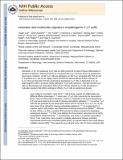| dc.contributor.author | Lee, Youjin | |
| dc.contributor.author | Awasthi, Amit | |
| dc.contributor.author | Yosef, Nir | |
| dc.contributor.author | Quintana, Francisco J. | |
| dc.contributor.author | Xiao, Sheng | |
| dc.contributor.author | Peters, Anneli | |
| dc.contributor.author | Wu, Chuan | |
| dc.contributor.author | Kleinewietfeld, Markus | |
| dc.contributor.author | Kunder, Sharon | |
| dc.contributor.author | Hafler, David A. | |
| dc.contributor.author | Sobel, Raymond A. | |
| dc.contributor.author | Regev, Aviv | |
| dc.contributor.author | Kuchroo, Vijay K. | |
| dc.date.accessioned | 2014-03-14T17:59:42Z | |
| dc.date.available | 2014-03-14T17:59:42Z | |
| dc.date.issued | 2012-09 | |
| dc.date.submitted | 2012-04 | |
| dc.identifier.issn | 1529-2908 | |
| dc.identifier.issn | 1529-2916 | |
| dc.identifier.uri | http://hdl.handle.net/1721.1/85641 | |
| dc.description.abstract | Interleukin 17 (IL-17)-producing helper T cells (T[subscript H]17 cells) are often present at the sites of tissue inflammation in autoimmune diseases, which has led to the conclusion that T[subscript H]17 cells are main drivers of autoimmune tissue injury. However, not all T[subscript H]17 cells are pathogenic; in fact, T[subscript H]17 cells generated with transforming growth factor-β1 (TGF-β1) and IL-6 produce IL-17 but do not readily induce autoimmune disease without further exposure to IL-23. Here we found that the production of TGF-β3 by developing T[subscript H]17 cells was dependent on IL-23, which together with IL-6 induced very pathogenic T[subscript H]17 cells. Moreover, TGF-β3-induced T[subscript H]17 cells were functionally and molecularly distinct from TGF-β1-induced T[subscript H]17 cells and had a molecular signature that defined pathogenic effector T[subscript H]17 cells in autoimmune disease. | en_US |
| dc.description.sponsorship | National Institutes of Health (U.S.) (1P01HG005062-01) | en_US |
| dc.description.sponsorship | National Institutes of Health (U.S.) (DP1-OD003958-01) | en_US |
| dc.description.sponsorship | Merkin Family Foundation for Stem Cell Research | en_US |
| dc.description.sponsorship | National Human Genome Research Institute (U.S.) | en_US |
| dc.description.sponsorship | Howard Hughes Medical Institute | en_US |
| dc.language.iso | en_US | |
| dc.publisher | Nature Publishing Group | en_US |
| dc.relation.isversionof | http://dx.doi.org/10.1038/ni.2416 | en_US |
| dc.rights | Article is made available in accordance with the publisher's policy and may be subject to US copyright law. Please refer to the publisher's site for terms of use. | en_US |
| dc.source | PMC | en_US |
| dc.title | Induction and molecular signature of pathogenic T[subscript H]17 cells | en_US |
| dc.type | Article | en_US |
| dc.identifier.citation | Lee, Youjin, Amit Awasthi, Nir Yosef, Francisco J Quintana, Sheng Xiao, Anneli Peters, Chuan Wu, et al. “Induction and molecular signature of pathogenic TH17 cells.” Nature Immunology 13, no. 10 (September 9, 2012): 991-999. | en_US |
| dc.contributor.department | Massachusetts Institute of Technology. Department of Biology | en_US |
| dc.contributor.mitauthor | Regev, Aviv | en_US |
| dc.relation.journal | Nature Immunology | en_US |
| dc.eprint.version | Author's final manuscript | en_US |
| dc.type.uri | http://purl.org/eprint/type/JournalArticle | en_US |
| eprint.status | http://purl.org/eprint/status/PeerReviewed | en_US |
| dspace.orderedauthors | Lee, Youjin; Awasthi, Amit; Yosef, Nir; Quintana, Francisco J; Xiao, Sheng; Peters, Anneli; Wu, Chuan; Kleinewietfeld, Markus; Kunder, Sharon; Hafler, David A; Sobel, Raymond A; Regev, Aviv; Kuchroo, Vijay K | en_US |
| dc.identifier.orcid | https://orcid.org/0000-0001-8567-2049 | |
| mit.license | PUBLISHER_POLICY | en_US |
| mit.metadata.status | Complete | |
